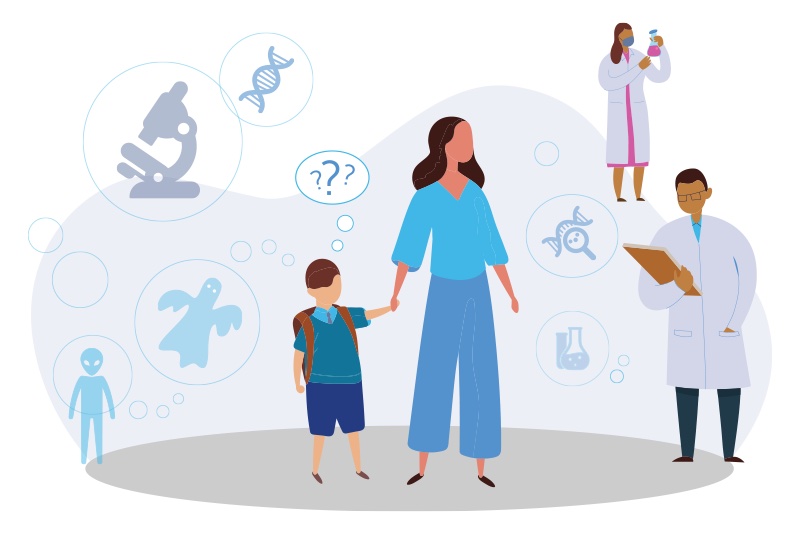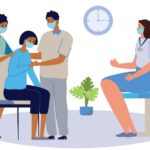Children with psychotic symptoms may merit genetic testing, finds study

A 6-year-old boy began seeing ghosts, aliens in trees, and colored footprints. More disturbingly, he heard voices coming from the walls and the school intercom telling him to hurt himself and others. Joseph Gonzalez-Heydrich, MD, a psychiatrist at Boston Children’s Hospital, put him on antipsychotic medications at age 9. The frightening hallucinations stopped.
While children are known for their active imaginations, it’s extremely rare for them to have true psychotic symptoms. Concerned, Gonzalez-Heydrich arranged for the boy to have genetic testing. One test, known as a chromosomal microarray analysis, found that he had lost a piece of his DNA: He had just one copy of the chromosome area 16p13.11 when he should have had two.
Another child, at age 4, had hallucinations with monsters, a big black wolf, spiders, and a man with blood on his face. She was found to have a duplicated piece of DNA.
Today, Drs. Gonzalez-Heydrich and his colleague David Glahn, PhD, have formed the Early Psychosis Investigation Center (EPICenter) at Boston Children’s to better understand these rare cases. In a study just published in the American Journal of Psychiatry, they have now genetically tested 137 children and adolescents with what’s known as early-onset psychosis, or psychotic symptoms appearing before the age of 18.
The findings open up a path toward diagnosing and caring for these devastating cases, helping traumatized families heal, and perhaps accelerating the development of better antipsychotic drugs.
Genetics of early psychosis: Copy number variants
More than 70 percent of the children in the study had begun experiencing psychosis before the age of 13. Twenty-eight percent met formal criteria for schizophrenia, having persistent and unrelenting symptoms. All underwent systematic testing for DNA duplications and deletions, together called copy number variants or CNVs. Eight percent were found to have CNVs known to be associated with neurodevelopmental disorders. This made CNVs as common as they are in children with autism, who are often screened for CNVs in the clinic.
Many parents feel like they are put under the microscope or are even accused of triggering their child’s symptoms.”
“Our findings make a strong case for chromosomal microarray testing in any child or adolescent diagnosed with psychosis,” says Catherine Brownstein, MPH, PhD in the Division of Genetics and Genomics at Boston Children’s, who co-directs the EPICenter and co-led the study with Elise Douard at the Université de Montréal. “Testing often brings closure for families and could help advance research.”
Ending years of uncertainty
Families are often relieved to learn that their child’s psychotic symptoms have a biological component. Their child’s psychosis may have been misdiagnosed, explained away as a normal developmental phase, attributed to stresses like being bullied, or even blamed on bad parenting.
“Many parents feel like they are put under the microscope or are even accused of triggering their child’s symptoms,” says Gonzalez-Heydrich. “It parallels what happened with autism a generation ago.”
In other cases, psychosis may be missed because the child also has autism or another developmental disorder. Just over a third of children in the study had a diagnosis of autism spectrum disorder, 12 percent had intellectual disability, and 18 percent had a history of seizures.
Finally, well-meaning clinicians may be reluctant to stigmatize a child by diagnosing them with psychosis, preferring to watch and wait. But if a child has symptoms of psychosis, finding a CNV might justify a trial of antipsychotic medications to see if they help.
“The longer psychosis goes untreated, the harder it is to treat later on,” says Glahn. “If we can treat it earlier and appropriately, the child will likely do better over their lifetime.”
How can parents recognize early psychosis?
Many children have behaviors that can seem like psychosis, like having an imaginary friend. But true psychosis is distressing to children and outside their control, say Glahn and Gonzalez-Heydrich.
In some children, psychotic symptoms come and go. Psychosis can appear when a child is under stress, angry, very depressed, or having mood swings. But in children with true schizophrenia, symptoms are persistent and extreme. This is very rare in children under 10, but becomes less rare in adolescence and early adulthood. For perspective, schizophrenia affects just 1 to 2 percent of the general population, including adults.
The longer psychosis goes untreated, the harder it is to treat later on. If we can treat it earlier and appropriately, the child will likely do better over their lifetime.”
The earliest signs of psychotic illness may be general. A child may become withdrawn. Their day-to-day functioning may decline, sometimes dramatically, interfering with school and relationships. Or they may have outbursts where they hadn’t before. Later, hallucinations and paranoia may take hold, causing the child to see and hear things that aren’t there, often things that feel threatening.
“It’s not simply the child thinking someone’s talking about them because they’re socially anxious,” says Gonzelez-Heydrich. “It’s multiple voices criticizing them, scaring them, telling them to do bad things. Or feeling that strangers are staring at them, planning to do them harm.”
From research to support and care
Besides encouraging treatment, finding a CNV in a child with psychosis allows other family members to be tested to see if they are at risk. Some CNVs can also cause medical complications like seizures, heart problems, or weakened blood vessels that can be watched and treated. Family members found to have CNVs may also be at risk for such medical problems, even if they don’t have behavioral symptoms.
Brownstein, who is also scientific director of the Manton Center for Orphan Disease Research at Boston Children’s, oversaw the testing. She notes that finding a CNV can help parents connect with other families for reassurance and support. Also, once a CNV is found, scientists can study what the lost or duplicated genes do. This could lead to a better understanding of the origins of early psychosis and possibly to better antipsychotic drugs, which have changed little since the 1950s.
“We don’t have medications tailored to CNVs yet,” Brownstein says. “But when parents get together, they can organize and identify research devoted to their particular CNV. We can study their children as a group and identify effective treatments a lot faster.”
Learn more about the Early Psychosis Investigation Center (EPICenter) at Boston Children’s.
Related Posts :
-

The adolescent mental health crisis: Bolstering primary care capabilities
The mental health crisis among children and teens shows no sign of abating, and COVID-19 has clearly made matters worse. ...
-

Suicide prevention in teens: Can we intervene through primary care?
The past year has seen a disturbing rise in suicidal thoughts and attempts among adolescents, with a spike of suicidal ...
-

When a parent has mental illness, how to support kids
Between the long hours, many responsibilities, and lack of control, few jobs in our society are as demanding as parenting. ...
-

COVID-19’s devastating toll: An increase in adolescent suicides and mental health crises
The past decade has seen worrisome increases in self-harm, suicidal ideation, and suicide attempts among adolescents. Two new studies from ...





